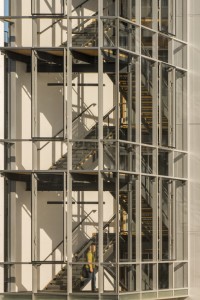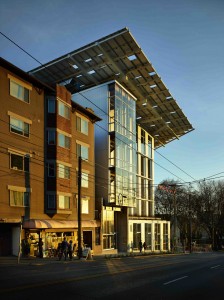![]() I should start by saying that architecture and design is what first got me “into” sustainability. As a result, for me personally, the word sustainability will forever be tied to the physical environments we inhabit. Fortunately, over time I’ve found that when architecture and sustainability intercept, some really amazing things can happen.
I should start by saying that architecture and design is what first got me “into” sustainability. As a result, for me personally, the word sustainability will forever be tied to the physical environments we inhabit. Fortunately, over time I’ve found that when architecture and sustainability intercept, some really amazing things can happen.
One of these amazing creations is the Bullitt Center in Seattle. This April 2013 article discusses the many ways that the building is pushing the boundaries of sustainable design. One notable goal is the achievement of the Living Building Challenge, the “the built environment’s most rigorous performance standard.” A few of the ways Bullitt Center will achieve this: 100% on-site renewable energy generation; 100% of water needs provided by harvested rainwater; and, a water-less toilet system that composts human waste and turns it into fertilizer.
The interesting thing about this article is that despite being written a year ago, it is still very relevant. Why? Well, in order to become a designated Living Building (in the entire world, there are only 5 so far) Bullitt Centre needs to be fully self-sufficient for 12 continuous months (after it is fully occupied), and it hasn’t hit the 12 month mark yet. Even so, there seems to be no doubt that it will achieve its goal.

Another aspect of this article resonates with me, in large part due to our in-class discussion about how maybe it isn’t enough for a company to create a green solution to a problem; the problem might be a consumer behaviour issue that needs to be addressed. (Remember: FreshPaper, which lowers food waste by extending the life of produce) This discussion came to mind when I read about Bullitt Center, because the tenants are forced to change their behaviour to adapt to the building. One example, there is no parking, only bike storage. Another example: a staircase is the only way to get from floor to floor (there is one slow elevator if needed, accessible by key-card only). While these are small sacrifices (it’s only a six-storey building), they are not ones that you often see in commercial architecture.
In my opinion, I think the Bullitt Center has truly pushed the envelope. (Talk about giving the Architect path to green growth some literal meaning!) And the best part is, Bullitt Center is committed to showing others how to do what they’ve done. According to the president and CEO of Bullitt Foundation, “If the building is still the highest-performing one of its kind 10 years from now, the experiment will have failed.” To me, this sounds like a challenge, and I’m excited to see who takes it on, and how.


Hi Dragana!
This is a great post. Sustainable buildings or ‘environmental design’ is definitely one of the more fascinating things about architecture today, and I also find the subject itself very intriguing. Considering the fact that big buildings like skyscrapers – or other large buildings that house offices, each produce so much waste just by operating on its own – it makes complete sense that so much could be saved just by converting a building into a self-sustaining structure, like the Bullitt Center. The Bullitt Center itself sounds very interesting, and I love how the architects designed the building to curb behaviours, like with the slow elevator and 6 flights of stairs. There aren’t enough companies out there that take their waste management or energy consumption into consideration, and I agree that it will be pretty cool to see the ‘Living Building Challenge’ pay off.
This is a very interesting post! I agree with you Dragana, as well as with Michelle that sustainable architecture is very intriguing and definitely a positive step towards an 100% sustainable future. As sad as it is to realize that buildings like the Bullit Center are very rare to find, it is great to know that there are definitely companies who are working on projects like these. What I found the most interesting about your post is that the Bullit Centre is not just environmentally designed itself but it actually encourages, or even more forces, tenants to live a sustainable lifestyle themselves. I think it is great that in order to live in this building you are actually required to believe in sustainable practices and aby by them.
Thoroughly I really enjoy your post because as we know that we are facing global warming and its main cause is pollution. I think this type of projects are really helpful to save our nature, thanks for sharing it.